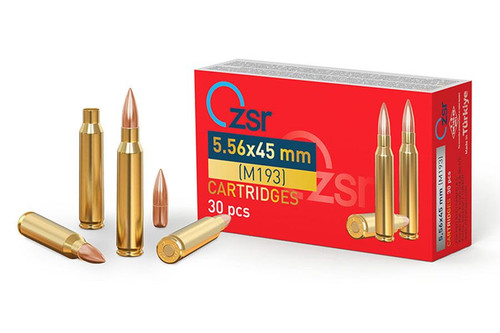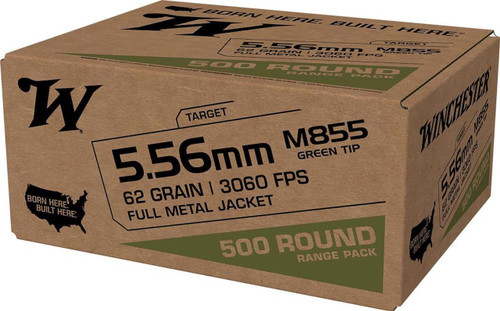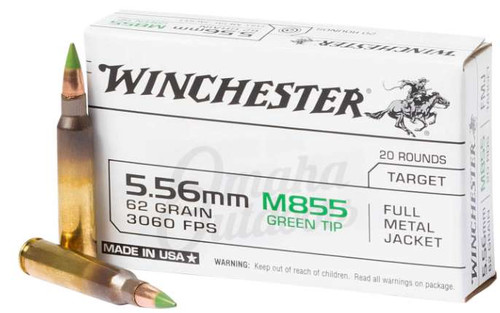5.56x45 NATO Ammo

5.56x45mm: In Depth
At the time of 7.62x51mm NATO’s adoption in the early 1950s, .30 caliber rifle cartridges were the undisputed kings of combat across the globe. The US had enthusiastically endorsed the idea of a “small bore” cartridge as far back as the 1890s, with the .30-40 Krag seeing service well before the turn of the 20th century. Sixty years and two World Wars later, the .30-06 Springfield sat enthroned as the victor of Europe and the Pacific, with the next-in-line .308 Winchester waiting eagerly to take the reins.
Yet the now-familiar cries continued to ring out from the US military for even-lighter rifles and ammunition. In addition, many believed the .30 caliber M14 was just too difficult to control during fully-automatic fire. In fact, the M14’s forgings had barely begun to cool before the military was again trialing rifles, this time in a sub-.30-caliber.
They soon found a suitable rifle. The AR-15, developed by Armalite under the direction of George Sullivan and Eugene Stoner, passed the scrutiny of multiple service branch trials before it was adopted first by the USAF, and later the Army, as the M16 and XM16E1, respectively.
The service cartridge for the new weapon was designated 5.56mm Ball, M193, and featured a 55-gr. FMJ bullet @ 3,250/fps.
The deployment of the rifle and cartridge in theater was rocky, at least initially. It took several years to implement a few small modifications to the M16 and to tighten up the specifications for the propellant inside the M193 load – these changes being made in response to soldiers experiencing catastrophic malfunctions in the field. However, by 1969, the situation had improved to the extent that the M16 and its .22 caliber ammunition were made standard issue across the entire US military.
Just one year later, in 1970, NATO moved to standardize both an infantry rifle and a second cartridge. This time around, their focus fell on an intermediate cartridge system – much like what the US had adopted in the 60s. Serious trials would take place between 1977-1980, during which the UK would field a 5mm round, and West Germany a caseless round, in addition to the more conventional submissions by the US and others that were based on the .223 Remington / 5.56mm M193 Ball round.
Ultimately, Belgium’s SS109 round won the day. FN developed the round using M193 as a starting point, adding a 62-gr. jacketed bullet with a steel core to improve target penetration.
The cartridge was henceforth known as 5.56x45mm NATO. It was nearly identical to the .223 Remington / M193; the main differences were the longer 62-gr. bullet, thicker case, and slightly higher operating pressure. NATO did not select a standard rifle to accompany the new cartridge.
It’s important to note that 7.62x51mm NATO was not immediately replaced, per se, rather than 5.56 NATO was offered as an effective, lighter-weight alternative. Most NATO nations, however, would quickly see the many benefits and roll out new rifles by the mid 80s.
The US would need to modify their service rifles to accommodate the new spec, which was designated M855 by the military. Barrel twist rates would increase drastically to 1:7 from the original 1:12 to stabilize not only the longer 62-gr bullets found in the main round, but also the much longer projectiles of the corresponding tracer ammunition (M856).
Domestically, the cartridge would see some use with specialty law enforcement units throughout the 80s and early 90s. Following 1997’s North Hollywood Shootout, however, local PDs around the country began equipping patrol cars with 5.56 NATO carbines such as Colt’s LE6920. Since that time, AR variants have further integrated into the SOPs and tactics of these same organizations.
After the sunset of the Assault Weapons Ban of 1994-2004 in the US, renewed interest in mag-fed semi-auto rifles has propelled this cartridge to supreme popularity. Along with .223 Remington, it is one of America’s most purchased rifle cartridges, certainly due to its compatibility with the AR-15 platform. Worldwide production is high, and surplus ammo is often made available in the US from other countries in addition to the vast domestic production. As the past century has shown, military cartridges in the US will always sell well commercially during their active service. This one is certainly no exception.
5.56x45mm NATO: Guns
5.56x45mm NATO is the most popular chambering for the AR-15 and its variants, not to mention the many battle rifles common to other NATO countries. Generally speaking, rifles made for this cartridge are semi-auto with detachable mags. If you’re looking for a bolt gun to hunt with, check out .223 Remington-chambered guns.
AR-15 Family
- Sig Sauer M400
- Knights Armament SR-15 E3 Mod 2
- FN FN-15
- Daniel Defense DDM4 V7
- HK MR556A1 (Piston)
- Custom build your own rifle from a lower receiver!
Non-AR Semi-Auto
- IWI Tavor
- FN SCAR 16
- Arsenal SAM5-94
- Desert Tech MDR
- FN M249S
- Ruger Mini-14
- CZ USA Bren 2
Bolt-Action
- Ruger American Ranch
- Mossberg MVP
- Q Mini Fix Bolt Action
Why Choose 5.56x45mm NATO?
5.56x45mm NATO runs at higher pressures than .223 Remington, and when loaded to M855 spec, also features heavier bullets than .223 Rem. As noted earlier, this is the most common chambering for AR-15s and many other semi-auto, mag-fed rifles. Also, ammo supply for this cartridge is generally plentiful, much like .223 Remington, though 5.56 NATO is more expensive to shoot.
Target / Competition
- Loads designed for match shooting.are available with bullet grain weights ranging from the 62-gr. M855 standard up through 75-gr.
- Mk262 mod 1 loads from Black Hills Ammunition feature a 77-gr. SMK FMJ HPBT bullet for long-range shooting.
Training
- Although more expensive than .223 Remington bulk ammo, 5.56x45mm NATO M855 Green Tip ammo is available if you like the idea of training with the same round that the military uses.
Home Defense
- Winchester makes a load called “Defender” that features a 64-gr. SP lead bullet suitable for this purpose. The ammunition is also marketed as a law enforcement round.
Hunting
- 5.56x45mm NATO isn’t a cartridge known for hunting loads. Look instead for .223 Remington loads, since those will shoot safely through the NATO-chambered guns.
5.56x45mm NATO: Ammo Brands and Loadings
5.56x45mm NATO is a military cartridge. What you can expect to purchase on the commercial market is most often in one of two distinct flavors: M855 or M193 (explained below). Also, there are some specialty 5.56x45mm NATO loads for match shooting and/or long-distance shooting. However, if you’re looking for hunting loads, check out .223 Remington.
Brands
- Federal, Winchester, Hornady, Black Hills Ammunition, PMC, IMI, PPU (Prvi Partizan), Norma
Standard Loadings
- M855 (Green Tip) - 62-gr. FMJ w/ steel penetrator @ 3,000/fps. - US version of NATO load, will sometimes be labeled SS109 on imported ammunition.
- M193 - 55-gr. FMJ loading @ 3,240/fps.
Bullet Weights
- 55-gr. - Found in 5.56x45mm NATO ammo loaded to commercial spec which is often labeled M193 or XM193.
- 62-gr. - Standard weight bullet. Will have a heavy steel core if load is M855 / SS109.
- 64.gr - 75-gr. - Heavier match-style and some personal defense bullets
- 77-gr. - Long-range bullets such as the Sierra MatchKing (SMK) found in Black Hills Ammunition’s Mk 262 mod 1.
Bullet Types
- FMJ (Green Tip) - M855 / SS109 loadings have a steel core ahead of the lead slug.
- FMJ (BT, HPBT) - Full metal jacket boat-tail bullets are found in standard and target-specific loads.
- SP - Soft-point lead bullets can be found in defense / LE ammo.
- Polymer Tip - Found in match ammo, sometimes known as ballistic tip. The polymer is said to improve the BC (ballistic coefficient) for stable flight at longer distances.
Average Velocities
- 55-gr. loads have .223 Remington-like velocity @ 3,150/fps to 3,250/fps.
- 62-gr. loads @ 3,000/fps to 3,100/fps.
- 77-gr. loads @ 2,750/fps.
5.56 NATO Ammo FAQ:
5.56x45mm NATO is a military round, .223 Remington is a commercial round. In terms of their exterior case dimensions, there is no difference, but .223 Remington typically runs at lower pressures than 5.56x45mm NATO. Most .223 Remington brass cases are not as thick-walled as 5.56x45mm NATO cases.
This is probably not the best idea. 5.56x45mm NATO barrels have longer chambers that effectively tolerate the higher pressures of NATO-spec ammo. You are risking a dangerous over-pressure situation if you use 5.56 NATO ammo in a .223 Rem barrel.
This is perfectly safe.
M855 is the US version of the 5.56x45mm NATO round adopted in the early 1980s.
M193 is the 55-gr. loading of 5.56x45mm NATO more akin to the load the US military used before M855. It is similar to many 55-gr. .223 Remington loads on the market.
Mk 262 refers to the heavy-for-caliber 77-gr. round developed by Black Hills Ammunition for long-range encounters.
All three rounds are commercially available in the US for civilian purchase. However, the military uses its own procurement system to purchase and verify specs for ammunition, so “true” M855, M193, etc. will only be found in the military pipeline (at least that’s the theory).











